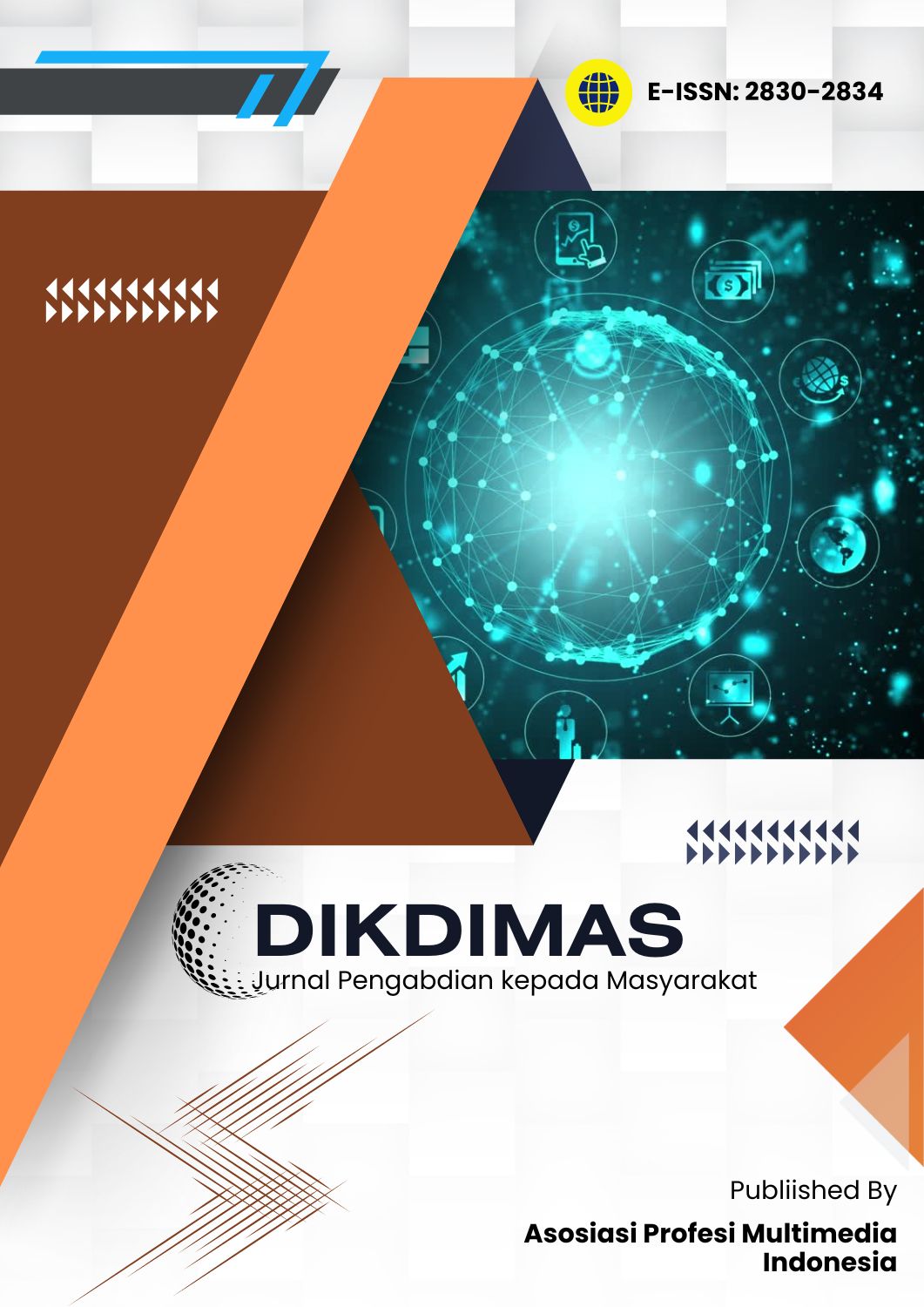Utilization of Coffee Skin Waste as Compost Fertilizer in Tapak Gedung Village, Kepahiang
Main Article Content
Abstract
Tapak Gedung is a village where most residents work as coffee farmers. This means that this village has a lot of coffee skin waste. This coffee skin waste is just left to lie around without being processed into something useful. Therefore, Thematic KKN students developed compost fertilizer from coffee skin waste in Tapak Gedung village which aims to optimize the natural potential in the form of abundant but unutilized coffee skins. This product has utility value for village communities, especially farmers, the majority of whom live in the village. Using coffee skin waste as a basic material in the composting process is an efficient solution to reduce the amount of coffee skin waste in the village. The decomposition process is accelerated by the addition of EM4 bacteria, helping in the decomposition of manure thereby optimizing the composting process. Compost is made from 80 kg of coffee husk bran, 200 mL of EM4 diluted with 18 L of water, 20 kg of animal waste, and 1 kg of urea. Thematic KKN students conveyed information about composting coffee husk waste to the Tapak Gedung village community through outreach, discussions and PowerPoint slide presentations. As a result, the compost that has been produced is distributed to village communities and applied to crops and agricultural land.
Downloads
Article Details
Copyright (c) 2023 Evi Maryanti, Zahra Kamila Rahma, Jenny Atri Lesmi, Mita Putri Agus, Mona Kristi Yanty, Putri Evony Habibah

This work is licensed under a Creative Commons Attribution-ShareAlike 4.0 International License.
- Authors retain copyright and acknowledge that the Journal of Multidisciplinary Applied Natural Science is the first publisher, licensed under a Creative Commons Attribution License.
- Authors are able to enter into separate, additional contractual arrangements for the non-exclusive distribution of the journal's published version of the work (e.g., post it to an institutional repository or publish it in a book), with an acknowledgment of its initial publication in this journal.
- Authors are permitted and encouraged to post their work online (e.g., in institutional repositories or on their website) prior to and during the submission process, as it can lead to productive exchanges and earlier and greater citation of published work.
References
Amalia, D., & Widiyaningrum, P. (2016). Penggunaan EM4 dan Mol Limbah Tomat Sebagai Bioaktivator Pada Pembuatan Kompos. Life Science, 5(1), 18–24. Google Scholar
Andrie, B. M., Yusuf, M. N., & Kurnia, R. (2021). Pemberdayaan Masyarakat Melalui Pengolahan Limbah Rumah Tangga Menjadi Pupuk Kompos. Abdimas Galuh, 3(2), 313–321. https://doi.org/10.25157/ag.v3i2.5830
Bonaventura, A., & Kusumawati, A. (2022). Effect of Coffee Grounds as Compost on The Growth of Vorstenlanden Tobacco. Journal of Global Sustainable Agriculture, 2(2), 44–49. https://doi.org/10.32502/jgsa.v2i2.4481
Dahlianah, I. (2015). Pemanfaatan Sampah Organik Sebagai Bahan Baku Pupuk Kompos Dan Pengaruhnya Terhadap Tanaman Dan Tanah. Klorofil: Jurnal Penelitian Ilmu-Ilmu Pertanian, 10(1), 10–13. https://doi.org/10.32502/jk.v10i1.190
Falahudin, I., Raharjeng, A. R. puji, & Harmeni, L. (2016). Pengaruh Pupuk Organik Limbah Kulit Kopi (Coffea Arabica L.) Terhadap Pertumbuhan Bibit Kopi. Bioilmi: Jurnal Pendidikan, 2(2), 108–120. https://doi.org/10.19109/bioilmi.v2i2.1135
Handayani, D., Indriani, R., Ilhamiwati, M., Srifitriani, A., & Arianto, T. (2022). Pemberdayaan SDA desa wisata tapak gedung sebagai upaya peningkatan ekonomi masyarakat. Masyarakat Berdaya Dan Inovasi, 3(1), 5–10. https://doi.org/10.33292/mayadani.v3i1.88
Indrawan, I. M. O., Widina, G. A. B., & Oviantari, M. V. (2016). Analisis Kadar N, P, K Dalam Pupuk Kompos Produksi Tpa Jagaraga, Buleleng. Jurnal Wahana Matematika Dan Sains, 9(2), 25–31. https://doi.org/10.23887/wms.v9i2.12650
Luthfi, A. H., Rosniawaty, S., Anjarsari, I. R. D., & Ariyanti, M. (2023). Pengaruh Pupuk Kandang Sapi dan Konsentrasi Urine Kelinci terhadap Pertumbuhan Bibit Kopi Liberoid Meranti. Paspalum: Jurnal Ilmiah Pertanian, 11(2), 348–354. https://doi.org/10.35138/paspalum.v11i2.628
Mitha, R. T., Nurahmi, E., & Anhar, A. (2020). Pengaruh Dosis Kompos Limbah Kulit Kopi Terhadap Pertumbuhan Beberapa Varietas Bibit Kopi Arabika (Coffea arabika L.). Jurnal Ilmiah Mahasiswa Pertanian, 4(2), 141–150. https://doi.org/10.17969/jimfp.v4i2.10984
Murrinie, E. D., Sridjono, H. H. H., & Arini, N. (2022). Pemanfaatan Limbah Ampas Tahu Menjadi Kompos pada Industri Tahu di Desa Ploso Kecamatan Jati Kabupaten Kudus. Muria Jurnal Layanan Masyarakat, 4(2), 72–79. https://doi.org/10.24176/mjlm.v4i2.7355
Novita, E., Fathurrohman, A., & Pradana, H. A. (2019). Pemanfaatan Kompos Blok Limbah Kulit Kopi Sebagai Media Tanam. AGROTEK: Jurnal Ilmiah Ilmu Pertanian, 2(2), 61–72. https://doi.org/10.33096/agrotek.v2i2.62
Rosniawaty, S., Maulina, A., Suherman, C., Soleh, M. A., & Sudirja, R. (2020). Modifikasi Penggunaan Subsoil Melalui Penambahan Bahan Organik Untuk Meningkatkan Pertumbuhan Bibit Kopi Arabika (Coffea Arabica L.). Paspalum: Jurnal Ilmiah Pertanian, 8(1), 37–45. https://doi.org/10.35138/paspalum.v8i1.157
Setyawati, H., Sari, S. A., Nathania, D., & Zahwa, N. (2021). Pengaruh Variasi Jenis Limbah Sayuran (Kubis, Sawi, Selada) Dan Kadar Em4 Pada Pembuatan Pupuk Kompos Dengan Proses Fermentasi. Jurnal ATMOSPHERE, 2(2), 1–7. https://doi.org/10.36040/atmosphere.v2i2.4102
Triawan, D. A., Banon, C., & Adfa, M. (2020). Biokonversi Kulit Kopi Menjadi Pupuk Kompos Pada Kelompok Tani Pangestu Rakyat Kabupaten Rejang Lebong. Jurnal Pengabdian Al-Ikhlas, 5(2), 159–165. https://doi.org/10.31602/jpaiuniska.v5i2.2817
Yulianti, M., Sarman, S., & Buhaira, B. (2022). Respons Pertumbuhan Bibit Kopi Liberika (Coffea liberic W. Bull Ex Hiern) Terhadap Aplikasi Pupuk Kandang Sapi Di Polybag. Jurnal Agroecotania : Publikasi Nasional Ilmu Budidaya Pertanian, 5(2), 23–34. https://doi.org/10.22437/agroecotania.v5i2.23037



 Evi Maryanti
Evi Maryanti
